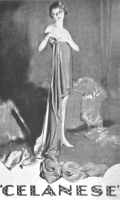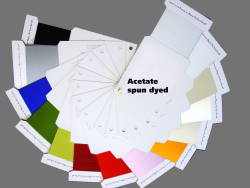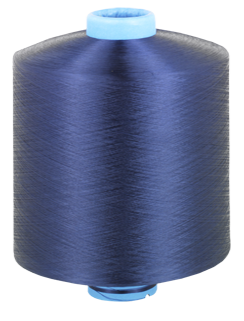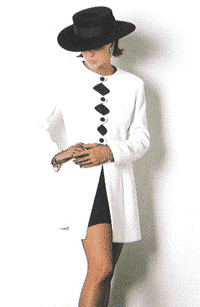
Introduction History:
Although cellulose acetate was first
prepared in 1865 by the French chemist Paul Schützenberger, it was not
until 1894 that the first industrial process for its manufacture was
patented in the UK by Charles Cross and Edward Bevan. At about the same
time, Little in the US made cellulose acetate filaments experimentally, as
did Bronnert in Germany. However, this material was essentially cellulose
triacetate, a rather intractable polymer, not readily soluble in commonly
available solvents. In 1904 George Miles, an American chemist, discovered
that if the polymer was partially hydrolyzed, it became soluble in
acetone.
Two Swiss brothers, Drs. Camille and
Henri Dreyfus, began chemical research in a shed behind their father's
house in Basel, Switzerland. In 1905, Camille and Henri developed a
commercial process to manufacture cellulose acetate, a compound that
seemed to offer a broad and untapped commercial potential. The Dreyfus
brothers initially focused on cellulose acetate film, which was then
widely used in celluloid plastics and motion picture film. By 1913,
Camille and Henri's studies and experiments had produced excellent
laboratory samples of continuous filament acetate yarn. In 1924, the first
commercial acetate filament was spun in the United States and trademarked
"Celanese."
After the war they concentrated their efforts in England, and in 1919
introduced the first acetate yarn Celanese. In 1924, they switched
entirely to the US where acetone and acetic anhydride were cheaply
available. In the same year, rayon became adopted as a generic term for
all 'artificial silk'.
Basic
Information:
Cellulose
acetate is a man made fibre of natural origin
with specific characteristics which allow the
production of beautiful, practical and
comfortable fabrics, whether used on its own or
mixed with other natural, artificial or
synthetic yarn or fibres

Acetate yarns were first to be used by the
textile industry in the early 20's. Since then,
acetate yarns have enjoyed a growth in all the
fashion sectors.
Today acetate yarns continue to play an
important role both in weaving and knitting. The
characteristics of acetate yarns make it
possible to meet the requirements of mass
production items, such as linings, as well as
the production on exclusive fabrics in the more
demanding markets of "niche" products.
Properties
| Specific weight |
|
| Tenacity |
|
| Water absorption |
|
| Moisture regain |
|
| Elongation |
|
| Melting point |
|
| Flammability UL94 |
|
| Electrical Resistivity |
|
| Solvents |
|
| Decomposed by |
|
| Combustion |
|
| Permeability to gases |
|
| Elastic modulus |
|
Acetate Characteristics
- Specific gravity of acetate/triacetate
fibers is lighter than that of cotton, viscose, cupro ammonium rayon
fibers and is nearly equal to that of wool fibers. Acetate/triacetate
fibers have bulky fabric hand and rich feeling.
- Filament yarns have luster and tactile
feeling as silk fibers. In addition, they have an excellent color
development.
- Acetate/triacetate fibers have optimal
moisture absorption, warmth retention and elasticity.
- Acetate/triacetate fibers are used for
pleat skirts thanks to the thermo-plasticity.
- Among others, acetate yarns
give to their fabrics the following characteristics:
- Natural luxury
- Silky feel
- Comfort
- Elegant drape
- Breathability
- Hypoallergenic
- Biodegradable
- Colour fastness and brightness
- Cross dyeing capacity
- Dimensional stability
Applications
FOR CLOTHING
- Women's Formal Wear
- Women's Nightgowns
- Coats
- Accessories for Japanese Dresses
- Neckties
- Blouses
- Sweaters
- Scarves, etc.
FOR HOME FURNISHINGS AND BEDDING]
- Blankets
- Bedclothes
- Fabrics for Curtains, etc.
FOR OTHER USES
- Umbrellas
- Cigarette Filters, etc
General Acetate Fiber Care Tips
Care should be
taken to use chemical solvents such as acetone and thinner in stain
removal, because acetate/triacetate fibers may be dissolved in these
solvents..
| Grades
|

|
new shade in blue:
Atlantico in spundyed acetate dtex 167
|

|
Processability
Background
information
Acetate filament yarns are referred to as
"Fibers of Beauty", because they have luster and tactile feeling
as silk fibers. The quantity of production in Japan is not so large, but
in the U.S.A., a large quantities of acetate filament yarns are used for
apparel manufacturing. Acetate filament yarns are same as rayon fibers in
those points that pulp is used as main raw material. However acetic acid
is reacted chemically, thus, acetate filament yarns have characteristics
of both vegetable fibers and synthetic fibers.
Acetate fibers are frequently used for
women's dresses and exhibits their beauty in the form of women's formal
wear, suits, coats or knitwear.
Acetate (staple tow) is used for almost all
cigarette filters.
Triacetate fibers are fibers to which more
acetic acid is combined than to acetate fibers.
Top of page


![]()





